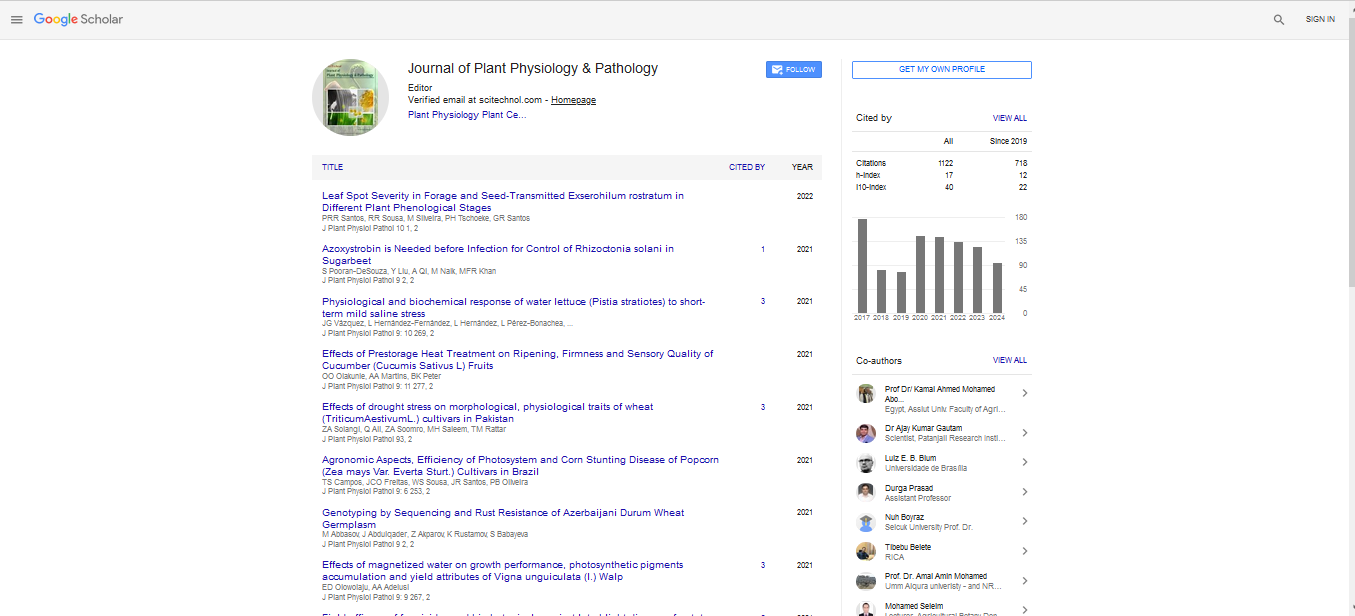Utility of the Internal Transcribed Spacer (ITS) as a potential barcode marker for the identification and discrimination of Kutsaga tobacco cultivars
Praise Tinyiko Chirilele
National Biotechnology Authority, Zimbabwe
: J Plant Physiol Pathol
Abstract
Ability to characterize plant cultivars is essential in hybrid proving, marker assisted selection in plant breeding, and authentication of food which is prone to adulteration. The importance of cultivar identification extends to forensic casework, which involves investigations on breeder rights infringement and produce theft. Various methods have been employed in cultivar identification; including morphological methods, chemical methods, and molecular methods. This study was carried out as a preliminary research on the use of the Internal Transcribed Spacer (ITS) region as a potential DNA barcode marker in the identification and discrimination of Kutsaga tobacco cultivars. The overall goal of this study was to develop an accurate, reliable and rapid method that can used to identify tobacco cultivars also applicable in forensic botany. Seeds for four tobacco cultivars; K26R, KRK66, T74, T72 and a Japanese cultivar Koufan were collected from the Plant Breeding department at Kutsaga Research Station. These seeds were grown in as sterile environment in tissue culture condition for four weeks. Tobacco leaf samples were randomly collected for each tobacco cultivar for DNA extraction. The ITS region in gDNA was amplified by a thermocycler using the ITS 1 forward primer and ITS 4-reverse primer. The ITS DNA amplicons were then sequenced using SeqStudio genetic analyzer. Five sequences were obtained, and then edited using BioEdit. Multiple Sequence Alignment was performed or the five sequences using MEGA X. The ITS sequence was analyzed in MEGA X employing; the Unweighted Pair Group Method with Arithmetic Mean (UPGMA), Neighbor-joining tree, Maximum parsimony tree and the pairwise genetic distance was computations. An NCBI blast search was performed to confirm the trustworthiness of the ITS sequences obtained. The molecular marker reproducibility test revealed that URP primers and TobRAPD primers lacked reproducibility of results whilst the SSR primer exhibited a level of reproducibility. The molecular marker efficiency test revealed that URPs have more discrimination power than RAPD marker and that SSR had no discrimination power. ITS region sequencing yielded 723 bp sequences with 34 conserved sites, 381 variable site, 349 Parsimony informativenes sites and 29 singleton sites. BLAST hits revealed that the tobacco varieties have high sequence identity matches with Nicotiana tabacum voucher SBB-0480 partial ITS sequence. It was concluded that the ITS was able to discriminate the three tobacco cultivars based on their sequence dissimilarity. KRK66 could not be distinguished from Koufan because they shared 100% sequence similarity. It was recommended that more research be done to perfect this method and trace parental lineages.
Biography
Praise T. Chirilele is a young genomics technician and researcher who in her time as a student researcher worked on various research in plants. In her final year as an undergraduate student, she worked on a research project entitled “Utility of the Internal Transcribed Spacer (ITS) as a potential barcode marker for the identification and discrimination of Kutsaga tobacco cultivars”. She has also worked on chromosome doubling projects in plant variety improvement programs. Presently she is working as a junior genomics scientist for the National Biotechnology Authority. Her work entails providing Next Generation Sequencing services to plant researchers and as well as bioinformatics analysis.
 Spanish
Spanish  Chinese
Chinese  Russian
Russian  German
German  French
French  Japanese
Japanese  Portuguese
Portuguese  Hindi
Hindi 
